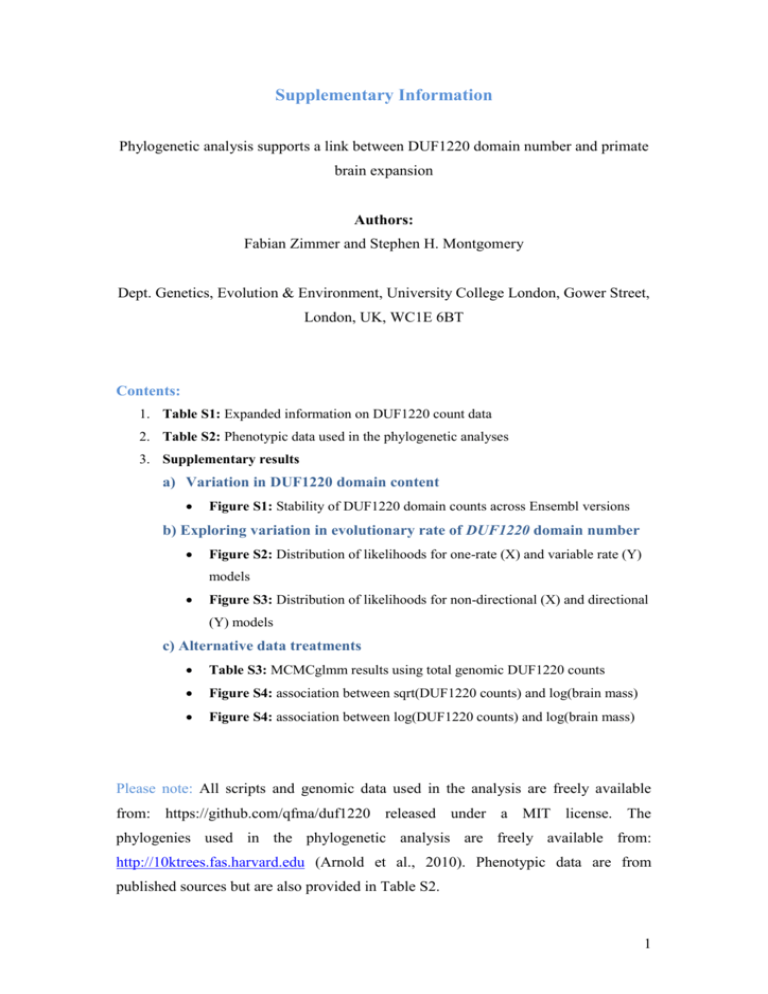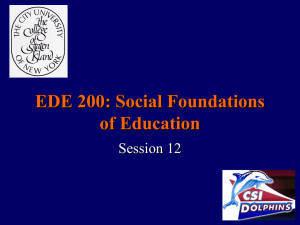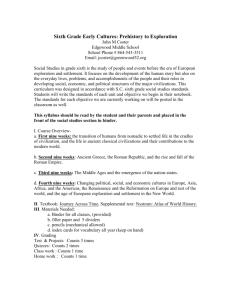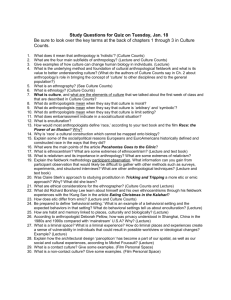Supplementary Information
advertisement

Supplementary Information Phylogenetic analysis supports a link between DUF1220 domain number and primate brain expansion Authors: Fabian Zimmer and Stephen H. Montgomery Dept. Genetics, Evolution & Environment, University College London, Gower Street, London, UK, WC1E 6BT Contents: 1. Table S1: Expanded information on DUF1220 count data 2. Table S2: Phenotypic data used in the phylogenetic analyses 3. Supplementary results a) Variation in DUF1220 domain content Figure S1: Stability of DUF1220 domain counts across Ensembl versions b) Exploring variation in evolutionary rate of DUF1220 domain number Figure S2: Distribution of likelihoods for one-rate (X) and variable rate (Y) models Figure S3: Distribution of likelihoods for non-directional (X) and directional (Y) models c) Alternative data treatments Table S3: MCMCglmm results using total genomic DUF1220 counts Figure S4: association between sqrt(DUF1220 counts) and log(brain mass) Figure S4: association between log(DUF1220 counts) and log(brain mass) Please note: All scripts and genomic data used in the analysis are freely available from: https://github.com/qfma/duf1220 released under a MIT license. The phylogenies used in the phylogenetic analysis are freely available from: http://10ktrees.fas.harvard.edu (Arnold et al., 2010). Phenotypic data are from published sources but are also provided in Table S2. 1 1. Table S1: Expanded information on DUF1220 count data Species Homo sapiens Pan troglodytes Gorilla gorilla Pongo abelii Nomascus leucogenys Papio anubis Chlorocebus sabaeus Macaca mulatta Callithrix jacchus Tarsius syrichta Microcebus murinus Otolemur garnettii O'Bleness et al. 2012 HMM nHMM whole genome Peptide whole genome exonic with CM exonic with CM excl. pseudogenes exonic without CM no feature 272 125 99 92 53 35 31 2 3 246 37 38 28 5 27 22 21 12 2 0 0 302 138 97 101 59 75 48 74 75 47 4 4 298 34 32 27 6 15 16 10 9 2 1 1 262 34 32 27 6 15 16 10 9 2 1 1 0 9 17 13 0 14 8 13 6 1 1 1 4 95 48 61 53 46 24 51 60 44 2 2 2 2. Table S2: Phenotypic data using in the phylogenetic analyses a) Adult brain volumes Species1 Homo sapiens Pan troglodytes Gorilla gorilla Pongo abelii2 Nomascus leucogenys3 Macaca mulatta Papio anubis Chlorocebus sabaeus4 Callithrix jacchus Tarsius syrichta Microcebus murinus Otolemur garnettii brain mass (mg) 1330000 405000 500000 333000 102000 93000 201000 108000 7600 3600 1780 10300 body mass (g) 65000 46000 105000 54000 5700 7800 25000 7800 280 125 54 850 brain volume (mm3) 1251847 382103 470359 321429 97505 87896 190957 103167 7241 3393 1680 9668 neocortex volume (mm3) 1006525 291592 341444 219800 65800 63482 140142 77141 4371 1769 740 4723 1 unless otherwise indicated all data from Stephan, H., Frahm, H., and Baron, G. (1981). Folia primatologica, 35(1), 1-29. 2 Data from Zilles, K. and Rehkämper, G. (1988). The brain, with special reference to the telencephalon. Orang-utan biology, 157-176. 3 Phenotypic data is from the closely related Hylobates lar and 4Erythrocebus patas. cerebellum volume (mm3) 137421 43663 69249 42900 12078 8965 18683 8738 757 376 234 1414 3 b) Pre and postnatal brain and body growth neonate Species1 Homo sapiens Pan troglodytes Gorilla gorilla Pongo abelii Nomascus leucogenys Macaca mulatta Papio anubis2 Chlorocebus sabaeus3 Callithrix jacchus Tarsius syrichta4 Microcebus murinus Otolemur garnettii adult brain size (g) body size (g) brain size (g) body size (g) 299.916 153.109 289.068 168.655 65.013 45.499 77.268 33.497 3.631 2.748 3.999 3318.945 1527.566 2070.141 1603.245 354.813 475.335 831.764 356.451 28.184 25.177 39.994 1330.454 404.576 500.035 364.754 102.094 92.897 160.325 66.681 7.603 3.771 7.907 59292.532 44977.985 124738.351 56885.293 5623.413 9908.319 14791.084 3732.502 358.922 119.437 763.836 1 Data from Capellini, I., Venditti, C., and Barton, R. A. (2011). Am. Nat. 177(1), 86-98. 2 Phenotypic data was from the closely related species P. hamadryas, 3 C. aethiops, 4 mean of three con-generics postnatal brain growth (g) 1030.538 251.467 210.967 196.099 37.081 47.398 83.056 33.184 3.972 1.024 3.907 postnatal body growth (g) 55973.588 43450.419 122668.210 55282.048 5268.600 9432.984 13959.320 3376.050 330.738 94.260 723.841 4 3. Supplementary methods and results a) Variation in DUF1220 domain content Our genomic DUF1220 counts are largely similar to previous estimates (O’Bleness et al., 2012) with some notable differences. In anthropoids, we find a significant negative relationship between the percentage deviation and time of divergence from H. sapiens (p = 0.005, R2 = 0.818) suggesting the nucleotide HMM performs better than BLAT searches in more distantly related species. However, only c. 20% of DUF1220 domains are found in exonic sequence data in most species. The exception is H. sapiens, where almost all DUF1220 domains are in predicted coding sequence. We explored the possibility that this difference may be due to annotation quality by estimating DUF1220 counts across different Ensembl versions for H. sapiens, P. troglodytes and M. mulatta. The number of exonic DUF1220 domains is consistent across versions for both P. troglodytes and M. mulatta; in H. sapiens; however, there is a trend for DUF1220 counts to increase (Figure S1), most probably due to improvements in assembly and annotation (O’Bleness et al., 2014). This either suggests that many DUF1220 domains in other primates occur in featureless regions of the genome, or that consistently poor annotation quality for P. troglodytes and M. mulatta leads to an underestimation of DUF1220 domains in exonic regions. Although we cannot rule the latter out, we note our phenotypic associations are consistent regardless of whether H. sapiens is included or not, and supplementary analysis with genome-counts produce similar results (see below). We therefore do not think this effect would alter our conclusion. We stress, however, that if DUF1220 domains are generally found in complex regions of the genome that are hard to assemble, count data may be affected. 5 Figure S1: Stability of DUF1220 domain counts across Ensembl versions 6 b) Exploring variation in evolutionary rate of DUF1220 domain number Methods We performed two analyses to test for heterogeneity and directional biases in the rate of change in DUF1220 counts, across the primate phylogeny in Bayes Traits (Pagel, 1999; freely available from: http://www.evolution.rdg.ac.uk/BayesTraits.html). To test for rate heterogeneity we compared the fit of a one-rate Brownian-Motion (BM) model and a variable rates BM model to the data (Venditti et al., 2011). These models are implemented using Markov chain Monte Carlo, run for 11,000,000 iterations with a burn-in of 1,000,000, and compared using log(Bayes Factors), calculated as 2(log[harmonic mean(complex variable rates model)] – log[harmonic mean(one rate model)]. The variable rates model accounts for rate heterogeneity by differentially stretching and compressing branch lengths and produces a posterior distribution of scaled phylogenies. The mean scaled branch lengths provide a visual indication of evolutionary rate when compared to the branch lengths of the input phylogeny. The posterior distribution of scaled phylogenies was subsequently used to test for a directional bias in DUF1220 domain variation by comparing the fit of a non-direction BM model to a directional BM model (Pagel, 1999; Organ et al., 2007). For these analyses we square-root transformed the DUF1220 counts, as commonly recommended for count data to improve normality (Sokal and Rohlf, 1981). However, square-root transformations may not adequately account for the large variance of count data, which is poisson distributed (O’Hara and Kotze, 2010; but see Ives, 2015). This rates analysis should therefore be viewed with some caution, but provides an initial assessment of the phylogenetic patterns of DUF1220 domain number evolution. Results Focusing on exonic DUF1220 domains associated with the CM promoter, we find evidence of heterogeneity in the rate of change in DUF1220 counts across the primate phylogeny (Bayes Factor = 10.254, ‘very strong’ support; Figure S2). We also find support for a directional model of expansion in DUF1220 number (Bayes Factor = 4.484, ‘strong’ support; Figure S3). A comparison of scaled branch lengths obtained from the variable rates model, and the branch lengths of the input time-tree confirms that H. sapiens has the highest rate of increase (Figure 1B). However, rates of evolution are high throughout apes (Figure S4), suggesting that DUF1220 increased 7 independently in other lineages, and that the human expansion is an exaggeration of a general ape trend. Figure S2: Distribution of likelihoods for one-rate (red) and variable rate (blue) models Figure S3: Distribution of likelihoods for non-directional (red) and directional (blue) models 8 Figure S3: Plot of scaled-branch lengths from the variable rates model against the given branch length in time. Labeled nodes: 1) G. gorilla terminal branch, 2) H. sapiens terminal branch, 3) branch leading to the last common ancestor (LCA) of Hominini, 4) branch leading to the LCA of Homininae, 5) terminal P. albelii branch, 5) branch leading to the LCA of Hominidae. Branch lengths were log-transformed to compress the scale. 9 c) Alternative data treatments Methods: does an annotation bias affect the results? In the main analysis we analyzed only DUF1220 domains in annotated exonic sequence, as we assume only these domains will be present in functioning proteins. However, as noted above, it is possible the difference between humans and nonhumans in the percentage of exonic domains reflects a consistent difference in annotation quality. We therefore sought to test whether our MCMCglmm results are robust to this possibility by repeating the key tests using total genomic DUF1220 counts (Table 1 “whole genome”). Results: does an annotation bias affect the results? The pattern of phenotypic associations is similar to those found with the exonic DUF1220 counts (see main text). There is evidence for a greater association with brain mass than body mass, with postnatal brain growth rather than prenatal brain growth and with neocortex volume (Table S3). Table S3: MCMCglmm results using total genomic DUF1220 counts Model 1. Brain mass + body mass Posterior mean 2.130 -1.060 95% C.I. 0.249 – 4.039 -2.589 - 0.479 pMCMC 0.014 0.929 2. Prenatal brain growth + postnatal brain growth -0.890 1.443 -3.198 – 1.383 -0.336 – 3.060 0.815 0.043 3. Postnatal brain growth + postnatal body growth 1.432 -0.691 0.2149 – 2.591 -1.812 – 0.410 0.011 0.918 4. Neocortex volume + cerebellum volume + rest-of-brain volume 4.291 -1.7152 -2.470 -1.089 – 9.3149 -8.975 – 5.501 -10.915 – 6.039 0.046 0.710 0.741 10 Methods: testing phenotypic associations We also explored the effects of alternative data treatments and transformations to test their influence on the reported phenotypic associations. Specifically, we repeated our analyses using Phylogenetic Least Square (PGLS) regressions to test for phylogenetically-corrected associations between DUF1220 counts and log- transformed phenotypic data (Table S2). All analyses were performed in Bayes Traits (Pagel, 1999; freely available from: http://www.evolution.rdg.ac.uk/BayesTraits.html) to account for phylogenetic non-independence, using a posterior distribution of the 100 most likely phylogenies obtained from the 10k Trees project (Arnold et al., 2010). Significance was determined using one-tailed tests as we specifically hypothesize a positive association. Regressions were performed using square-root and log-transformed DUF1220 counts to check whether or not the data transformation affected the relationships. Results from sqrt-transformed DUF1220 domain data CM-associated exonic DUF1220 counts are significantly associated with brain mass across primates (t10 = 3.165, p = 0.005, R2 = 0.455), but are not associated with body mass (t10 = 0.922, p = 0.189, R2 = 0.066). The relationship with brain mass is robust to the exclusion of H. sapiens (t9 = 3.810, p = 0.002, R2 = 0.569), and remains if body mass is included as a covariate in a multiple regression analysis (t8 = 8.937, p < 0.001, R2 = 0.878). The association with brain mass is also found when only anthropoids (t7 = 3.196, p = 0.008, R2 = 0.531) or only apes (t5 = 4.976, p = 0.008, R2 = 0.832), are included in the analysis, and when all apes are excluded from the analysis (t7 = 2.749, p = 0.020, R2 = 0.519). Separation of pre- and postnatal development specifically links DUF12220 number to postnatal brain growth. Analyzed separately, the association with prenatal brain growth is not significant (t9 = 1.641, p = 0.067, R2 = 0.197), but it is strongly significant for postnatal brain growth (t9 = 3.850, p = 0.002, R2 = 0.573). If both traits are analyzed together in a multiple regression, the positive association with postnatal brain growth remains significant (t7 = 5.033, p < 0.001, R2 = 0.757), even if H. sapiens is excluded (t6 = 2.477, p = 0.021, R2 = 0.466), whilst prenatal brain growth is not (t7 = -2.879, p = 1.000). Multiple regression analysis also confirms the association is specific to postnatal brain growth (t7 = 7.824, p < 0.001, R2 = 0.853), as opposed to body growth (t7 = -4.581, p = 1.000). 11 Finally, we examined the hypothesized relationship with neocortex volume (e.g. Keeny et al., 2014a,b), but also consider cerebellum volume, as this region coevolves with the neocortex (Barton and Harvey, 2000), has expanded in apes (Barton and Venditti, 2014), and shows high levels of NBPF expression (Popesco et al., 2006). The association is significant for neocortex volume (t10 = 3.162, p = 0.005, R2 = 0.454) and cerebellum volume (t10 = 2.767, p = 0.010, R2 = 0.390). However, when the volume of the rest-of-the-brain (RoB) is included as a covariate, the association with neocortex remains (t8 = 2.614, p = 0.015, R2 = 0.586; RoB: t8 = -1.952, p = 1.000), whilst the association with cerebellar volume is no longer significant (t8 = 1.220, p = 0.129, R2 = 0.421; RoB: t8 = -0.825, p = 1.000). A multiple regression between neocortex and cerebellar volume also suggests a stronger positive association with the neocortex (neocortex: t8 = 1.684, p = 0.065; cerebellum: t8 = -1.125, p = 1.00, R2 = 0.507). Results from log-transformed DUF1220 domain data CM-associated exonic DUF1220 counts are significantly associated with brain mass across primates (t10 = 4.770, p < 0.001, R2 = 0.655; Figure S4). The association with body mass is weak (t10 = 1.880, p = 0.045, R2 = 0.228). The relationship with brain mass is robust to the exclusion of H. sapiens (t9 = 3.952, p = 0.002, R2 = 0.586), and remains if body mass is included as a covariate in a multiple regression analysis (t8 = 7.119, p < 0.001, R2 = 0.852). The association with brain mass is also found when only anthropoids (t7 = 4.100, p = 0.002, R2 = 0.651), or only apes (t5 = 10.165, p = 0.018, R2 = 0.954), are included in the analysis, and when all apes are excluded from the analysis (t7 = 2.455, p = 0.029, R2 = 0.462). Separation of pre- and postnatal development specifically links DUF12220 number to postnatal brain growth. Analyzed separately, the association with prenatal brain growth is significant (t9 = 2.435, p = 0.019, R2 = 0.351), but it is much more strongly significant for postnatal brain growth (t9 = 5.521, p < 0.001, R2 = 0.735). If both traits are analyzed together in a multiple regression, the positive association with postnatal brain growth remains significant (t7 = 5.498, p < 0.001, R2 = 0.827), even if H. sapiens is excluded (t6 = 2.180, p = 0.032, R2 = 0.604), whilst prenatal brain growth is not (t7 = -2.419, p = 1.000). Multiple regression analysis also confirms the association is specific to postnatal brain growth (t7 = 7.564, p < 0.001, R2 = 0.862), as opposed to body growth (t7 = -3.197, p = 1.000). 12 Finally, we examined the hypothesized relationship with neocortex and cerebellum volume. The association is significant for neocortex volume (t10 = 4.869, p <0.001, R2 = 0.664) and cerebellum volume (t10 = 4.037, p = 0.001, R2 = 0.576). However, when the volume of the rest-of-the-brain (RoB) is included as a covariate, the association with neocortex remains (t8 = 3.525, p = 0.003, R2 = 0.775; RoB: t8 = 2.426, p = 1.000), whilst the association with cerebellar volume is no longer significant (t8 = 1.153, p = 0.141, R2 = 0.587; RoB: t8 = -0.563, p = 1.000). A multiple regression between neocortex and cerebellar volume also suggests a specific positive association with the neocortex (neocortex: t8 = 2.583, p = 0.016; cerebellum: t8 = 1.672, p = 1.000, R2 = 0.727). 13 Figure S4: association between sqrt(DUF1220 counts) and log(brain mass) Figure S5: association between log(DUF1220 counts) and log(brain mass) . 14 References: Arnold C, Matthews LJ, Nunn CL. 2010. The 10kTrees website: A new online resource for primate phylogeny. Evol Anthropol 19:114–118. Barton RA, Harvey PH. 2000. Mosaic evolution of brain structure in mammals. Nature 405:1055–8. Barton RA, Venditti C. 2014. Report Rapid Evolution of the Cerebellum in Humans and Other Great Apes. Curr Biol 24:2440–2444. Ives AR. 2015. For testing the significance of regression coefficients, go ahead and log-transform count data. Methods Ecol Evol in press O’Bleness M, Searles VB, Dickens CM, Astling D, Albracht D, Mak ACY, Lai YYY, Lin C, Chu C, Graves T, Kwok P-Y, Wilson RK, Sikela JM. 2014. Finished sequence and assembly of the DUF1220-rich 1q21 region using a haploid human genome. BMC Genomics15:387. O’Bleness MS, Dickens CM, Dumas LJ, Kehrer-Sawatzki H, Wyckoff GJ, Sikela JM. 2012. Evolutionary history and genome organization of DUF1220 protein domains. G3 (Bethesda) 2:977–86. O’Hara RB, Kotze DJ. 2010. Do not log-transform count data. Methods Ecol Evol 1:118–122. Organ CL, Shedlock AM, Meade A, Pagel M, Edwards S V. 2007. Origin of avian genome size and structure in non-avian dinosaurs. Nature 446:180–184. Pagel M. 1999. Inferring the historical patterns of biological evolution. Nature 401:877–84. Popesco MC, Maclaren EJ, Hopkins J, Dumas L, Cox M, Meltesen L, McGavran L, Wyckoff GJ, Sikela JM. 2006. Human lineage-specific amplification, selection, and neuronal expression of DUF1220 domains. Science 313:1304–1307. Sokal RR, Rohlf J. 1981. Biometry: the principles and practice of statistics in biological research. 2nd ed. San Francisco. Stephan H, Frahm H, Baron G. 1981. New and Revised Data on Volumes of Brain Structures in Insectivores and Primates. Folia Primatol35:1–29. Venditti C, Meade A, Pagel M. 2011. Multiple routes to mammalian diversity. Nature [Internet] 479:393–396. 15







